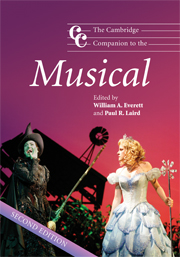Book contents
- Frontmatter
- Part I Adaptations and transformations: before 1940
- Part II Maturations and formulations: 1940–1970
- Part III Evolutions and integrations: after 1970
- 11 Stephen Sondheim and the musical of the outsider
- 12 Choreographers, directors and the fully integrated musical
- 13 From Hair to Rent: is ‘rock’ a four-letter word on Broadway?
- 14 The megamusical: the creation, internationalisation and impact of a genre
- 15 ‘Something borrowed, something blue’: the marriage of the musical and Europe
- 16 New horizons: the musical at the dawn of the twenty-first century
- Part IV Legacies and transformations
- Notes
- Select bibliography
- Index
13 - From Hair to Rent: is ‘rock’ a four-letter word on Broadway?
from Part III - Evolutions and integrations: after 1970
Published online by Cambridge University Press: 28 September 2011
- Frontmatter
- Part I Adaptations and transformations: before 1940
- Part II Maturations and formulations: 1940–1970
- Part III Evolutions and integrations: after 1970
- 11 Stephen Sondheim and the musical of the outsider
- 12 Choreographers, directors and the fully integrated musical
- 13 From Hair to Rent: is ‘rock’ a four-letter word on Broadway?
- 14 The megamusical: the creation, internationalisation and impact of a genre
- 15 ‘Something borrowed, something blue’: the marriage of the musical and Europe
- 16 New horizons: the musical at the dawn of the twenty-first century
- Part IV Legacies and transformations
- Notes
- Select bibliography
- Index
Summary
Among the etymological legacies of the 1960s is the once ubiquitous family of musical categories distinguished by the word ‘rock’ somewhere within a compound name. Today one seldom hears such terms as ‘jazz rock’ or ‘symphonic rock’, but on Broadway the term ‘rock musical’ has retained currency, either as a show's formal subtitle or as an appellation casually used by critics and others to describe a particular work. Yet despite widespread use of the term over the past four decades, no scholarly or even semi-formal definition of the ‘rock musical’ has ever appeared in print. Instead, the ‘rock musical’ has remained an extremely pliable category, capable of embracing a wide range of characteristics.
Despite the lack of rigour with which the term has been used through the years, a number of common features identify ‘rock musicals’. Virtually anyone who has written on the history of the musical has remarked – positively or negatively – on the first appearances of rock-influenced music on Broadway in the mid-1960s. Hair, subtitled ‘An American Tribal Love-Rock Musical’, has been universally accepted as the first example of the genre. Almost immediately after that landmark show, other works appeared with similar subtitles, but there were also shows with rock scores that were never identified as such by their producers. In fact the latter case soon predominated, and consequently, many New York critics began to employ the term ‘rock musical’ to identify any stage work with even the slightest hint of popular styles.
- Type
- Chapter
- Information
- The Cambridge Companion to the Musical , pp. 235 - 249Publisher: Cambridge University PressPrint publication year: 2008
- 1
- Cited by



